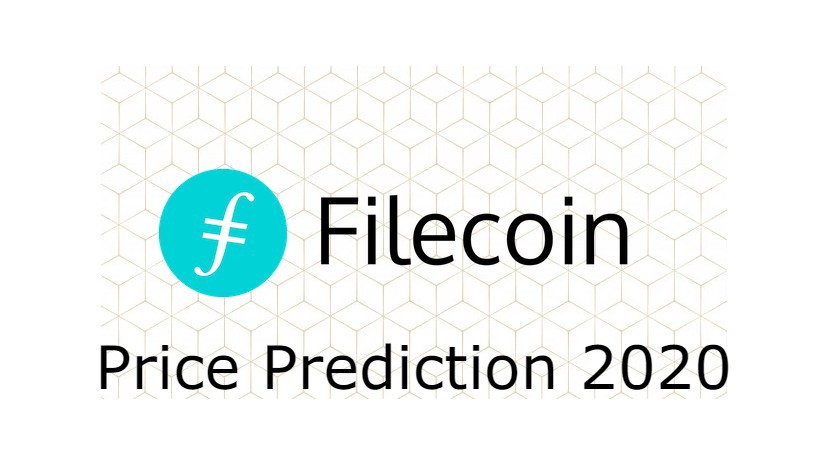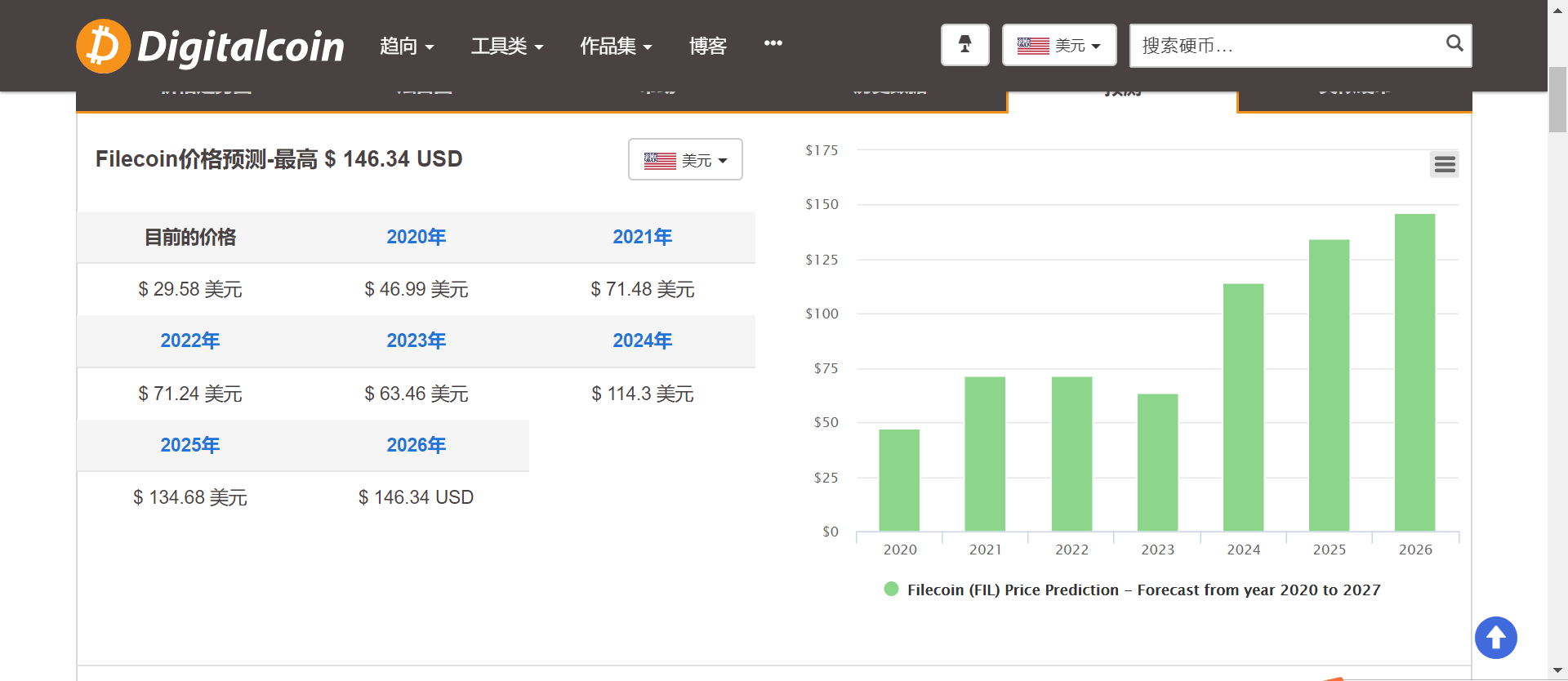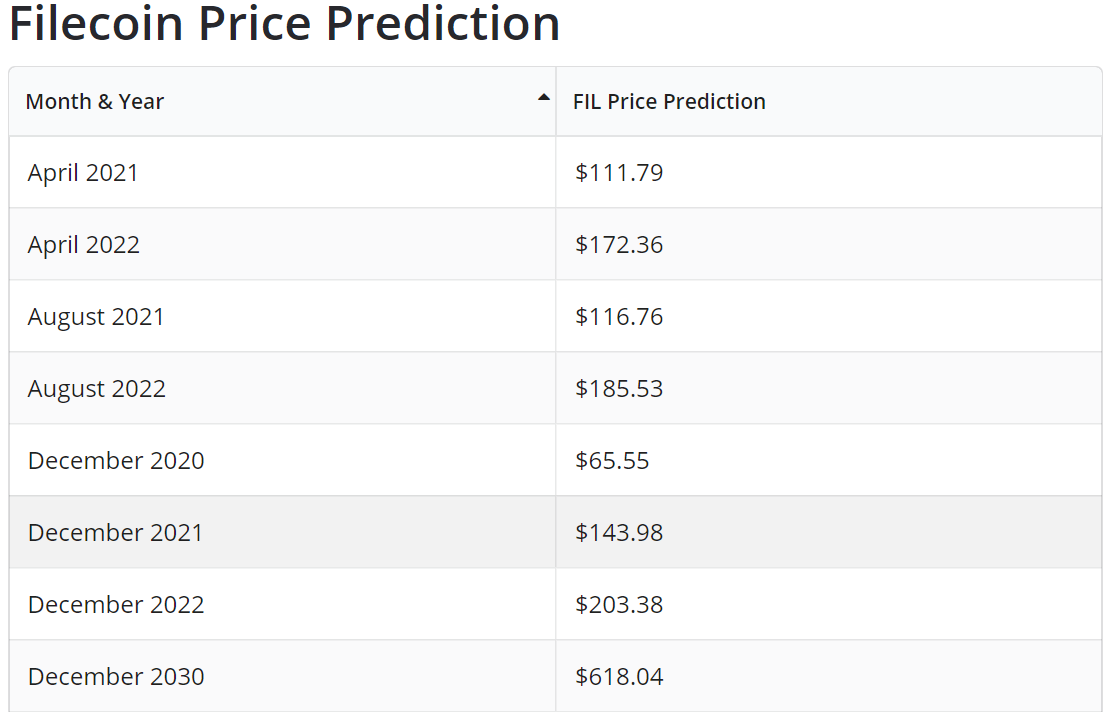Publisher: Chengdu Tianyue Cloud Computing (ID: rzy19660119)
Release time: November 2020
Preface: What is Filecoin (FIL)? Is Decentralized Storage the Next Big Opportunity? Some institutions' Filecoin price predictions for 2020 and the next few years.

After three years of development, the main network of Filecoin, one of the most anticipated projects in the encryption field, has started operation on October 15. At the beginning of the ICO, eight venture capital companies including Sequoia Capital and DCG Group received $257 million in venture capital. At that time, it attracted the attention of countless investors, so that everyone gave high hopes.
In these long three years, there have been disappointments but also hopes. The launch of the mainnet on October 15 finally let most people breathe a sigh of relief, and they will all express a feeling"Finally online!"If you are a fan of Filecoin (FIL), then the price prediction data from some foreign websites in this article may be worth your reference.
first level title
Why distributed storage?
In addition to the great hope of decentralized financial services (DeFi), another expected practical application in the future may be a decentralized storage system based on blockchain technology.
Although these projects have achieved preliminary results, major breakthroughs are still awaited.
The explosive growth of data volume has made the corresponding solutions more and more popular. From websites to videos, animated images (GIF), high-definition photos, local data and backup of various files, more and more data is stored online in in cloud storage so you can access it anytime.
What is cloud storage? It is nothing more than a collection of many servers from a single provider.
first level title
What are some typical use cases for cloud storage?
Typical use cases of cloud storage, such as the following:
Personal cloud:Dropbox is probably the most well-known personal cloud provider, and the client on the user's terminal device will synchronize the required data. Dropbox has more than 500 million registered users (of which 100 million users are new users in 2017), 11 million paying users, and 56% of Fortune 500 companies have teams using Dropbox products. It is not difficult to see that Dropbox has a huge SAM and TAM. The 500 million registered users are almost all TAMs that the company can touch and convert. Such a huge customer base is only owned by giants such as Google and FB.
Website Hosting:Perhaps the best in this field is Amazon. AWS has the broadest global cloud infrastructure. No other cloud service provider offers as many regions with multiple Availability Zones connected by low-latency, high-throughput, and highly redundant networks as we do. AWS now operates 77 Availability Zones in 24 geographic regions around the world, and announced plans to add three new AWS Regions in Indonesia, Japan, and Spain.
Backup and archive:first level title
What's wrong with current cloud storage?
In recent years, more and more data failure problems have made headlines. Data security in cloud storage is of paramount importance, and for this reason it must be protected from hackers, technical vulnerabilities patched in a timely manner, and administrative access rights abused.
What exactly is IPFS?
What exactly is IPFS?
Officially, IPFS is an open source peer-to-peer network that aims to be a faster, more reliable alternative to the decades-old internet standard Http (Hypertext Transfer Protocol).

IPFS uses its own protocol to distribute data to nodes in the network, and users can use dedicated clients or standard clients (web browsers) to access stored data through the central gateway.
IPFS will distribute and store data in the nearest node network to ensure that the data is backed up, that is, if a single node goes offline, it will not affect the normal access to data.
Of course, this series of work is not only so simple to complete, the whole process also involves the collaborative use of protocols such as Libp2p, IPLD, Multi formats, CoinList, SAFT Project, etc. These protocols are also developed by the protocol laboratory. The concept is briefly introduced:
ibp2p: a modular networking stack for peer-to-peer applications and systems;
PLD: the data model of the interoperability protocol;
Multi formats: a collection of protocols for future-oriented systems;
CoinList: a token sale and investment platform;
SAFT Project: A Legal Framework for Coin Fundraising.
first level title
What makes Filecoin different?
We all know that Filecoin (FIL) adds a business layer to IPFS. In the decentralized market, miners can obtain "FIL" rewards by protecting the availability of user data (storage market) and delivering user data (retrieval market).
At the same time, in the process of providing storage and retrieval, the Filecoin network will rely on PoSt (Proof of Time and Space) and PoR (Proof of Replication) to supervise the work of miners, thereby ensuring that the only copy of customer data remains on physical storage.
In order to ensure the high-quality and orderly operation of the network, a pre-mortgage mechanism is now added. If miners want to obtain FIL rewards, they must provide collateral (FIL) to the network, but the pre-mortgage FIL will be refunded after 540 days.
Participating in Filecoin network mining requires very high hardware requirements. Unlike Bitcoin, which only relies on the chip of the machine, it is necessary to improve the cloud computing ability of the machine to obtain Bitcoin.
According to the current network situation, if you want to participate in Filecoin network mining, you first need to install macOS or Linux system, Windows system is not yet supported. Also, only certain quad-core CPUs and processors that support Intel SHA extensions (Intel Ice Lake processors or AMD Zen microarchitecture processors) are supported.
Therefore, participating in the Filecoin network and receiving rewards requires an 8-core CPU, a minimum of 32GiB of RAM, and a fast flash drive (SSD) with enough storage space to store the current Lotus chain, which is the minimum configuration requirement for running a Lotus node.
first level title
Storage Miners in the Filecoin Network
Assembled according to this minimum configuration requirement, the cost of a storage miner may exceed 6,000 US dollars, but the server assembled with this configuration standard cannot save any user data.
The storage space of the Filecoin Space Race test network reached about 230PiB. At that time, the size of ordinary miners exceeded 650TiB. Therefore, according to the experience of the competition, in order to obtain block rewards in the main network, storage miners need at least 100-500TiB of capacity, which means that a qualified miner The investment cost will be more than 40000 USD.
So what kind of concept is the standard hardware of 100TiB space? An ordinary notebook computer has a storage capacity of about 0.5TiB (512GiB), and 100TiB is equivalent to the space of 200 notebooks. According to the current calculation of 3,500 yuan for a notebook, the price of 200 notebooks is 700,000 yuan, so many people want to use it for home use. It is just a dream for computers to participate in Filecoin mining.
first level title
Filecoin will face a tough but happy battle
The Filecoin battle is like David's battle against Goliath, which is 100 developers of Protocol Labs (protocol lab) and thousands of developers of Amazon Web Services (Amazon), Microsoft (Microsoft), and Google Cloud (Google Cloud) struggle.
The above are only centralized opponents, and do not include other blockchain projects. For example, SIA (SC), Storj (STORJ), 0Chain (ZCN), Neo (NEO) and other storage projects.
Although these projects cannot be compared with Filecoin for now, they are opponents worthy of attention after all.
The circulating supply of FIL displayed on the blockchain browser is 16 million pieces, and the maximum supply of FIL is 2 billion pieces, which means that there are still 1.98 billion pieces that have not yet been released.
According to MarketsandMarkets, the world's second largest market research institution, recently released a global data storage market size forecast: the data storage market size in 2019 will be 56.8 billion US dollars, and it is expected that by 2024, the global data storage market will break through the 100 billion US dollar mark, reaching 1022. According to the compound annual growth rate of 12.48% during the forecast period (2019-2024), it is estimated that the data storage market size in 2020 will be 65.8 billion US dollars.
Assuming that Filecoin takes advantage of low-cost data storage to occupy 10% of the scale through one year's efforts, that is, 6.08 billion US dollars. At the same time, according to the function model that Filecoin gradually decreases with the block for 6 years and halved, about 3 100 million FIL, and based on the standard that stock trading flows account for 30% of the total circulation, about 90 million FILs will be used for circulation in the first year, and the price of FIL in the first year is calculated according to the data storage market. The price of 1 FIL is about 73 US dollars. Calculated according to the 30% overflow rate of the currency price in the digital asset market, the price of 1FIL increased by 30% from the price of 73 US dollars to about 95 US dollars, which is equivalent to about 650 yuan in RMB.
According to the above standards, by 2024, Filecoin will work hard to occupy 30% of the data storage market, which is about 20.5 billion US dollars. In 4 years, FIL is expected to release 1 billion FIL, with 30% of the transaction flow accounting for the total circulation rate and Based on the calculation of the currency price overflow rate in the digital asset market, the price of 1FIL will be about 133 U.S. dollars in 4 years, equivalent to about 900 yuan.
*The above excludes the situation where the banker controls the market.
Now, blockchain-based decentralized storage projects have not yet become mainstream, mainly because the technology is still in its infancy and the market penetration is not yet high.
Companies like Amazon, Microsoft, and Google have a long history with better relationships, more money, more users, better hardware, and most importantly, the resources to attract more customer of.
first level title
Prediction of Filecoin price by some prediction websites
Then enter the long-awaited part--Filecoin future price prediction, so that everyone can have a clearer understanding of Filecoin mining and future prices.
1.Walletinvestor.com
image description

(Walletinvestor.com website)
2.Digitalcoinprice.com
image description

(Source: digitalcoinprice.com Filecoin (FIL) price prediction)
3.cryptocurrencypriceprediction.com
image description

(Source: cryptocurrencypriceprediction.com Filecoin (FIL) Price Prediction)
The prediction of the future price of Filecoin on the above website is based on Ai's technical analysis.
end
end
The main idea of Filecoin is to create a next-generation data storage platform, aiming to become a new decentralized form of iCloud and Dropbox. More attention should be paid to the commercial application of Filecoin in the future data storage market and the impact that its emergence will bring to the entire Internet society. What kind of impact will come, and you should not fall into the "magic barrier" of currency prices!

Filecoin is on the rise. Whether the future will be triumphant or mediocre, we just need to wait and see.
**Serious statement: The price prediction of Filecoin in this article is based on Ai artificial intelligence and technical analysis of traders. It is for reference only and does not make investment advice.